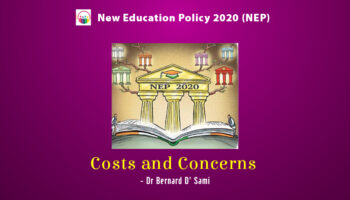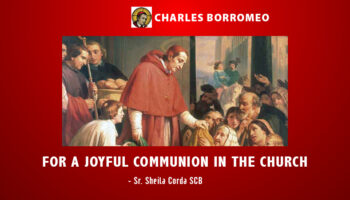A Document on the Contemplative Dimension of Religious Life
Contemplate is a circular letter published by the Congregation for Institutes of Consecrated Life and Societies of Apostolic Life on 15 October 2015. This document is continuation and culmination of the two documents that were released during the Year of Consecrated life (2014 November to 2016 February), namely, Rejoice and Keep Watch. This circular is an invitation for all Religious (Institutes and Societies) to “evaluate their contemplative dimension in their daily life; to recognize the mystery of grace which sustains them, excites their passion and transforms them.” The document draws much from the Song of Songs.
Seven Steps Towards Contemplation
- Song of Songs at the Heart of Contemplation
The Song of Songs is a celebration of beauty of love between man and woman. It is a love that leads to exodus—crossing streets and squares (Song of Songs 3:2). It is a symphony of spousal love that includes the restlessness in searching for the beloved (dodim’) and goes beyond to the whole universe to experience this love (ahaba’). Consecrated men and women need to encounter Christ in sacred places as well as in the streets and squares (2).

- The Gaze of Contemplation
To contemplate means to think deeply, to observe something attentively, in a way that provokes amazement (4). This is normally seen in the way we gaze at nature. This gaze helps one to go beyond what is gazed and to search for the beauty’s creator (Wisdom 13:1-9). The centre of Christian contemplation is Christ crucified. Contemplation, therefore, is a gaze of faith, fixed on Jesus. “In the simple of worlds of a peasant of Ars to his holy Curé (St. John Mary Vianney): “I look at him and he looks at me (5).” Hence, contemplation is basically gaze on God and the work of His hands (Psalm 8:4).
- Contemplation as a Search for the Face of God
To love means being ready for the daily apprenticeship of the search (8). The “Song of Songs” presents love as a search, searching for the beloved in the darkness of the night, through streets and squares, facing dangers and struggles (SS.3:2,3). “It is your face, O Lord, I seek. Hide not your face.” (Ps 26:8). This search is to change the searcher in relation to the beloved in dedication and commitment, as in the case of the woman in her search of her bridegroom (SS 2:5; 5:8).
- An Experience of the Dark Night of the Soul
Our search is a call to humility because we recognise “potential atheists’ in ourselves. Seeking God requires crossing through the night and even staying there for some time (14). In scripture, the night is the time of distress, interior struggle, and spiritual warfare, as we see happen to Jacob at the Jabbok (Genesis 32: 25). Francis of Assisi, St. John of the Cross, and Mother Teresa are some of the saints who experienced the struggle of the mysterious “presence-absence”of God.
- Religious Life as a Way of Beauty
Encountering God is experiencing beauty. St. Augustine realised it through the process of his conversion. “Late have I loved thee, O Beauty so ancient and so new.” This way of beauty is in silence, contemplation, struggle and pain (22,23). This beauty calls to ecstasy, leading one out of the self in the movement of love. “My beloved is mine and I am his” (SS 2:16). The beauty in the Bible appears as the signature of divine and human gratuitousness (44). In our journey as consecrated persons, we need to recognise the traces of Beauty, a path towards God.
- Religious Life as a Call towards Prayerful Contemplation
Prayerful contemplation is the identity mark of a religious in intimate relationship with his/her Beloved. Prayer brings us back to the centre of our being. It gives us over to Jesus, while it heals our self and restores our unity. It is a journey within, a journey that leads us to experience the God within.
- Consecrated Persons as Participants in the Dance of Creation
Consecrated men and women are participants in the dance of creation as singers and guardians. Singers: Called to revive our identity as creatures, we give praise in the immense symphony of the universe. Guardians: Called to watch over the beauty and harmony of creation, like sentinels waiting for the dawn (60). The canticle of Francis of Assisi (Laudato Si’….) continues to resonate today with a call to wonder and recognise the original beauty that marks us as creatures.
Quotes from the Text:
- “Just so, in this life, two persons of reasonable intelligence, who love each other dearly, seem able to understand each other without making any signs, merely by their looks.” (St. Teresa of Jesus) (5)
- “The greatest challenge (of religious) is the ability to continue to see God with the eyes of faith in a world which ignores his presence.” (6)
- “Contemplation is mind, hearts and knees.” (Pope Francis) (9)
- “Saint Benedict, the tenacious seeker of God, affirms that a monk is not one who has found God; he is one who seeks God for a lifetime.” (12)
- “The Divine Master is at the bottom of our soul as at the bottom of Peter’s boat… At times, it seems as though he sleeps, but he is always there, ready to save us, ready to answer our requests.” (Bl. Charles de Foucauld)
- “Without holiness, good turns chaotic; without good, beauty becomes accidental. Good and Beauty shine however with just one voice” (45).
- “A new relationship with nature is not possible without a new heart, one that can recognise the beauty in every creature, the unique dignity of man, the need for relation, and openness to a you in which everyone recognises the same origin, the divine You” (61).

To subscribe to the magazine Contact Us





